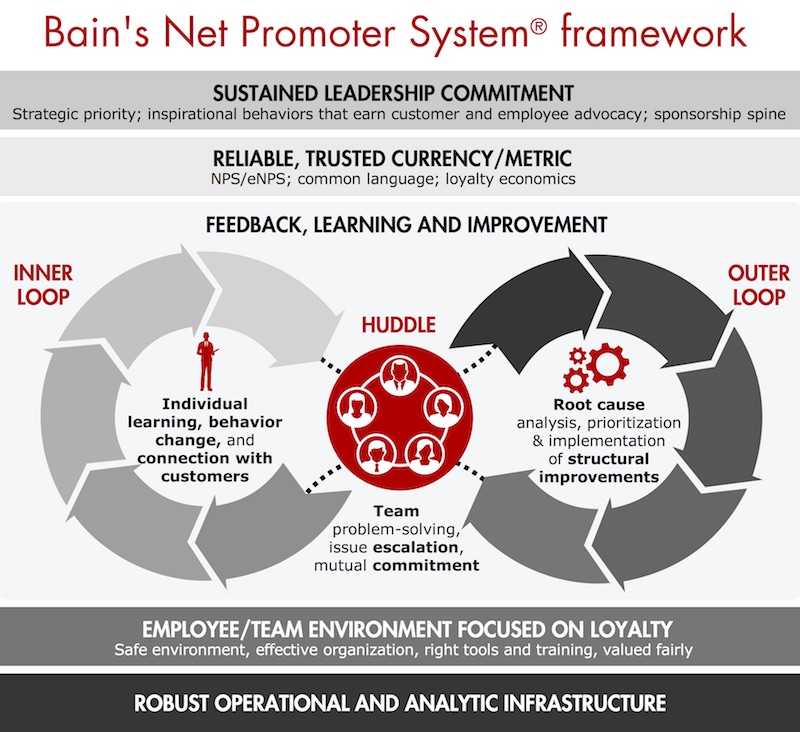Net Promoter System® Quiz – Final part, and full quiz
Here is the full Net Promoter System true/false quiz. The new questions are the final five below. All other questions are the same as those I have posted over the last five weeks. A link to the answers follows below the questions. The questions are all learning checks at the end of chapters in our book Net Promoter – Implement the System. You will see that the sections below correspond to the various parts of the Bain Net Promoter System framework, as illustrated at the top of this article. Our book concentrates on implementing the system. My experience is that the most difficult part of implementation is ensuring the reliability and trustworthiness of the research. That is why there are more questions on this subject than the others.
Decide whether each statement is true or false, note your answers, then click on the link to the answers.
Introductory questions
- The answers to “How likely are you to recommend [Company] to a friend were found to be the best predictors of future revenue trends among all the questions tested by Fred Reichheld in his 2003 Harvard Business Review article The One Number You Need to Grow.
- The answers to the “How likely are you to recommend [Company] to a friend were found to be the best growth predictors for all industries tested, in the same HBR article.
- The Net Promoter Score scale must start at zero and go to ten. All other scales are invalid.
- Reichheld’s research showed that customer behaviors really do change depending on their classification as Promoters, Passives or Detractors.
- The definitive reference source for the Net Promoter System is The Ultimate Question 2.0, and no other information on the design and implementation is available from Reichheld and Markey.
Reliable, Trusted currency / metric
- If your competitive benchmark NPS number is better than that of your main competitor, you will take market share from them moving forward.
- Good NPS scores start at 30, great scores at 40, and you are world-class at 50.
- Consistent trends in numbers that are based on small sample sizes are always useful. You do not need sample sizes for all competitors to be the same, for example.
- All customers are considered equal by benchmark survey suppliers, so customers who spend a lot have the same weight as those who do not spend much.
- Even the font you use in an email asking customers to take a survey can make a big difference.
- To make sure you are doing a good job, you should always send a survey request to every customer who phones your service center.
- Embedding at least the rating question in a survey request email improves response rates by about 2.5 times.
- Culture makes no difference to survey responses, so it is always fair to compare countries’ NPS performance with each other.
- Low survey response rates tend to give overly optimistic NPS scores.
- The more questions there are in your survey, the more likely people are to complete the survey, as it is clearer that you value their opinions.
- The cost of renewing an existing annuity contract is typically one-tenth the cost of acquiring a new customer.
- If your overall brand NPS trend is better than that of your competitors, it is safe to assume that all parts of your business will benefit in the same way.
- Bain experience suggests that the average time lag between a relative NPS improvement and new product revenue improvement is 6 to 18 months.
- Since contra-revenue is not in a standard P&L statement, it should not be considered when calculating the lifetime value of a customer. (Contra-revenue includes things like discounts from standard list prices, and rebates given to resellers.)
- To avoid bias, all customers should be considered equal in your research, no matter how much they spend with you or your competition.
Feedback, learning and improvement
- The Inner Loop is where you follow up with customers on individual feedback items. The Outer Loop is where you work across departments on feedback that has come from many customers.
- All common customer improvement suggestions are equally important. You should staff up to work on as many as you can afford to.
Robust operational and analytic infrastructure
- Customer Experience is clearly a part of brand marketing and the customer experience leader should always report to the Marketing leader.
- Humans are currently the best single solution for evaluating and prioritizing verbatim responses to surveys.
Employee / team environment focused on loyalty
- Happy employees are the single most important customer satisfaction predictor in most businesses.
- The Net Promoter System work just as well as an employee experience improvement process as it does for customers.
- Satmetrix is the only official provider of Net Promoter professional certification.
Sustained leadership commitment
- To be most persuasive, customer experience leaders should usually start their presentations with a story about a single customer, a quote from a customer executive, or a single emotionally-charged statement.
- Senior leaders who participate in a company’s Executive Sponsor program should have no experience in the client’s industry. Customers will welcome their outside views.
Once you have decided on your answers, click here.
Feel free to disagree and debate the answers in the comments section below the answers. I recognize that some answers my be difficult to understand without the context of the corresponding book chapter.



